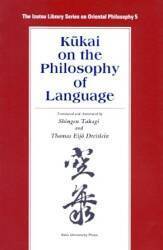
Kyōto Temples
Kyōto
Kyōto was Japan's Imperial capital for over a thousand years, from 794 to 1868. Emperor Kanmu moved the Imperial capital here in 794, when it was called Heian-kyō.
The capital was moved to escape the control Buddhism was exerting around the old capital in Nara. After all, Shintō said that the Emperors were the descendants of the gods. But before long, Buddhism had a strong presence at the new capital. We'll see several of the major temples on this page.
K's PlaceI was staying at K's Place, just a 10 minute walk from the futuristic Kyōto Station. All but one of these temples are just a 10 minute walk from the station or where I stayed. Kiyomizu-dera is the farthest away, but it's also within easy walking distance. This map is centered on the station:
Higashi Hongan-ji
Our first stop is Higashi Hongan-ji. It's about 640 meters north of Kyōto Station, 610 meters west of K's Place.
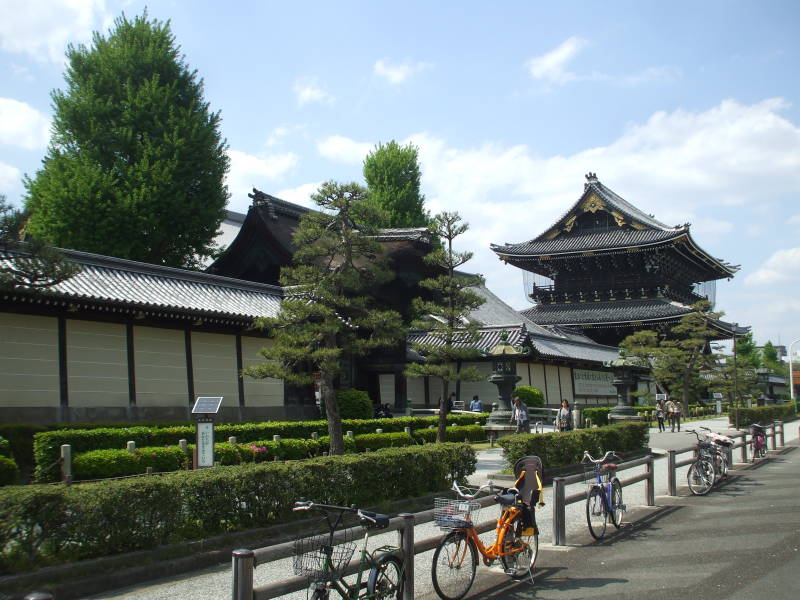
Jōdo Shinshū or Shin Buddhism, known as The True Essence of the Pure Land Teaching, is the most widely practiced branch of Buddhism in Japan. It was founded around 1200 when the Shōgun had taken most of the political power away from the Emperor.
In 1602 the Shin Buddhist movement had become so powerful that Shōgun Tokugawa Ieyasu split it into two sects: Nishi or Western, and Higashi or Eastern.
So, here we are at Hiagashi Hongan-ji, the Eastern Temple of the Original Vow. You won't miss the gate as you walk north along the main street headed toward the center of the city.
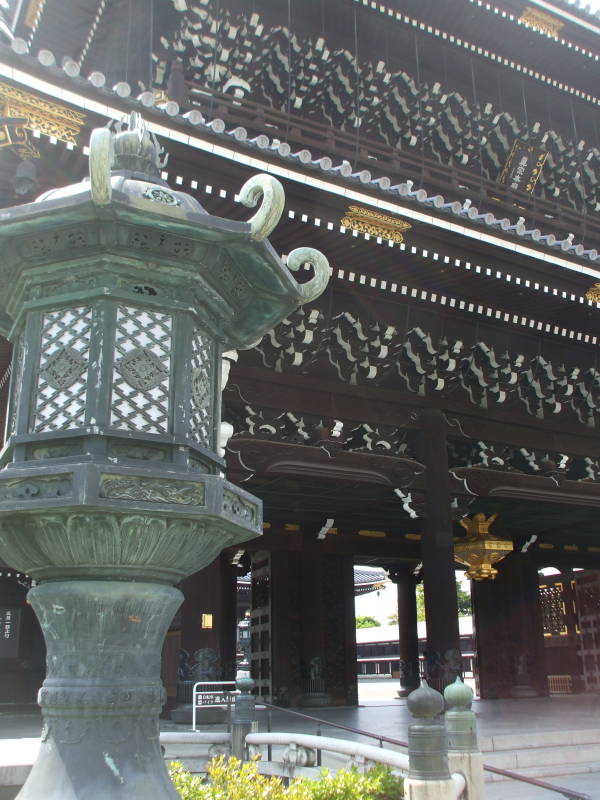
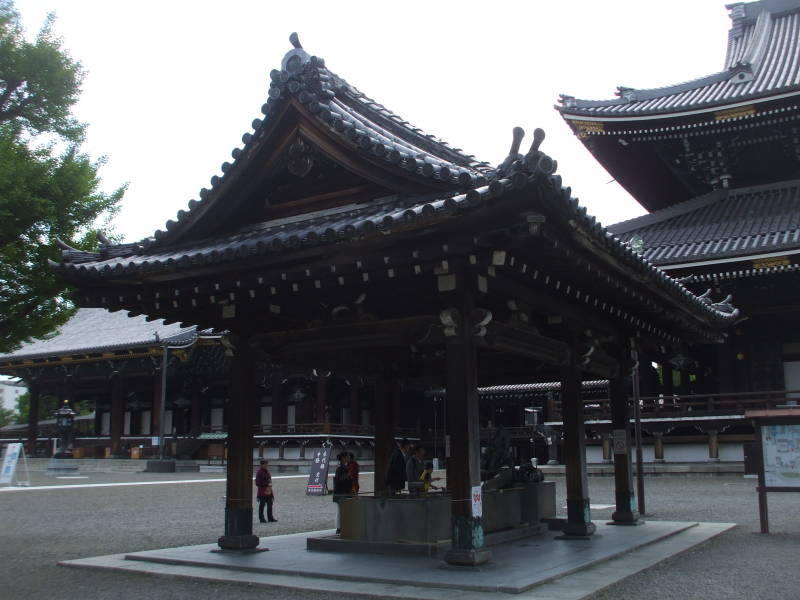
The chozu-yakata or shelter over the ablutions fountain is just inside the gate. The basin itself is the tsukubai. That term is based on the verb tsukubau, meaning "to bow down", to humble yourself. Wash your hands and mouth, and we'll continue.


The bell is in the corner of the courtyard.
Sukhāvatīvyūha
Sūtra
Below is the Amida-dō or Amida Hall. Amida, or Amitābha in Sanskrit, is the principal Buddha in Pure Land Buddhism, of which Shin Buddhism is a branch. The scriptures of Mahayana Buddhism describe Amida/Amitābha as a celestial Buddha. Amida has the skandha or aggregate of discernment, pure perception and the deep awareness of emptiness of phenomena.

Two large temples are connected by a covered wooden walkway. The larger temple is the Goei-dō or Founder Hall. This is the largest wooden structure in Kyōto.
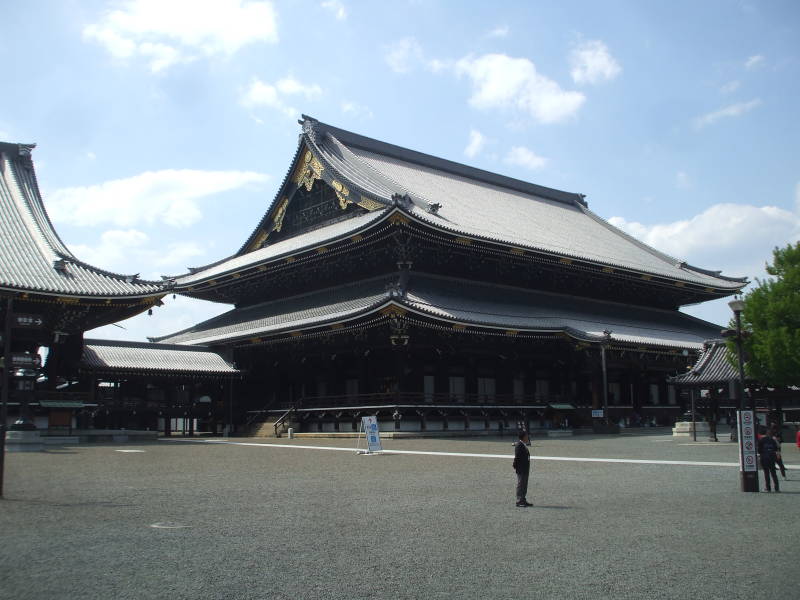
You must remove your shoes when you step onto a wooden surface at most temples.
This wooden box dispenses plastic bags out the two holes in the top. You step out of your shoes onto the platform holding the box. Then you put your shoes in a bag to easily carry them during your visit. At the end of your visit, you return the used bag for future use. It's the endless cycle of rebirth manifested in polyethylene.


There are broad wooden balconies around the temple, and a covered wooden walkway joining them.
Photography isn't allowed inside the temple halls, but let's peep through the doors into the Founder's Hall. Tatami or straw mats cover the floor.

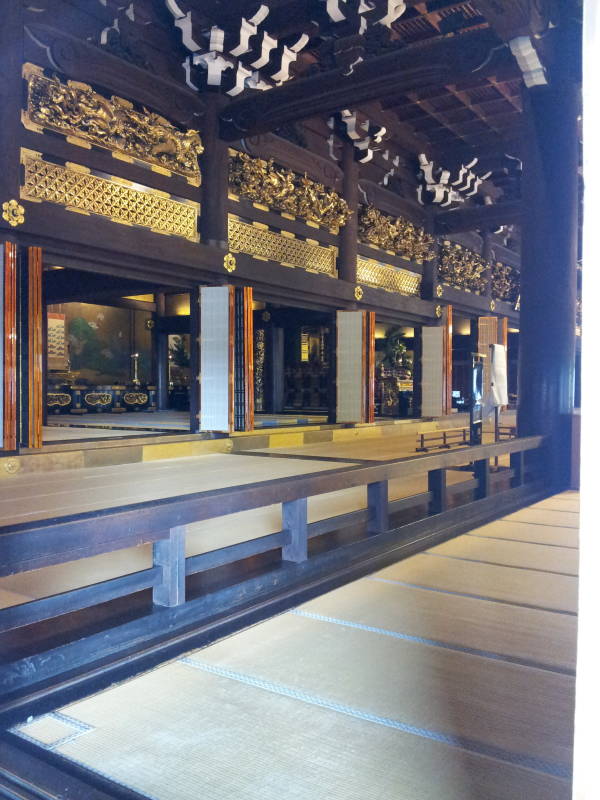
I came in through the smaller gate, directly across from the Amida Hall.
The larger gate is the Geoi-dō Mon or the Founder's Hall Gate.

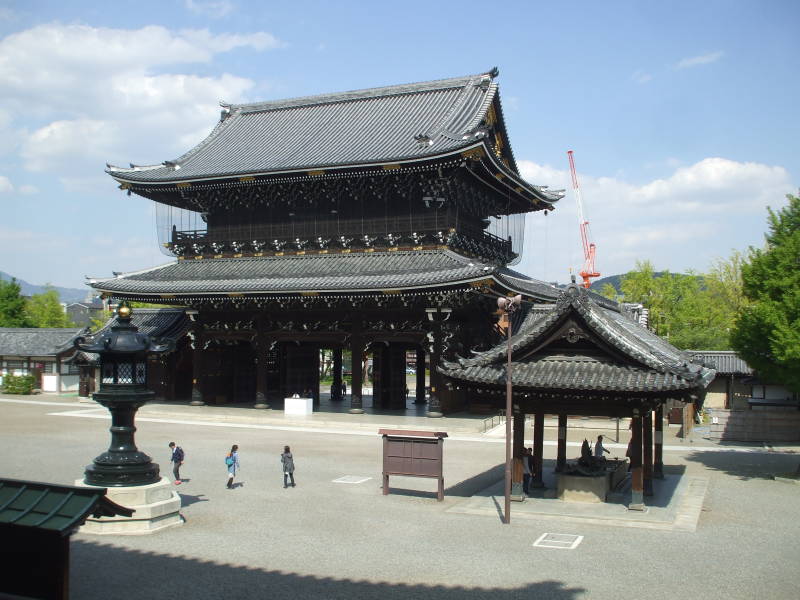
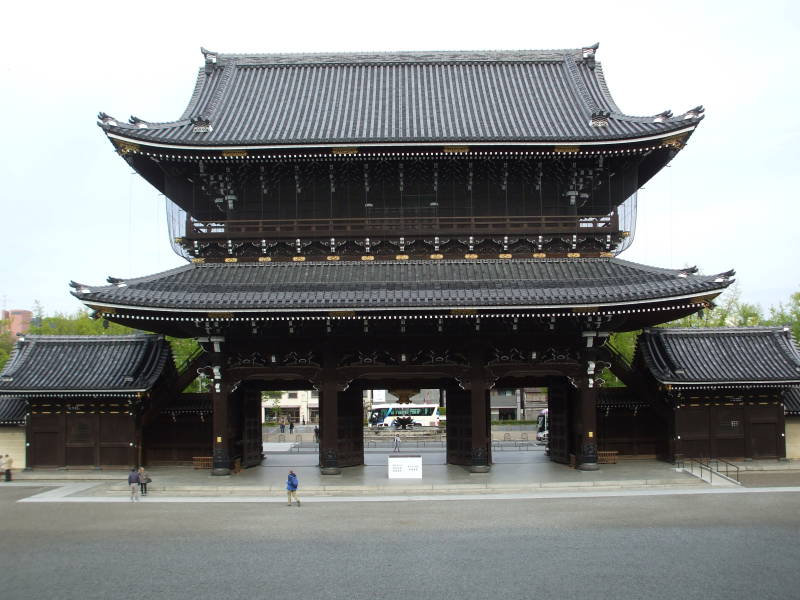
Nishi Hongan-ji
Nishi Hongan-ji, the Western Temple of the Original Vow, is, of course, the one that lies to the west of the other one. It's about 640 meters west of Higashi Hongan-ji, the eastern one.
The two temple complexes are laid out very similarly. This temple was built in 1591 as the sole Pure Land headquarters temple. When Shōgun Tokugawa Ieyasu split the sect in 1602, the other complex was built to the same overall layout. I'm again entering through the smaller gate toward the southeast corner.
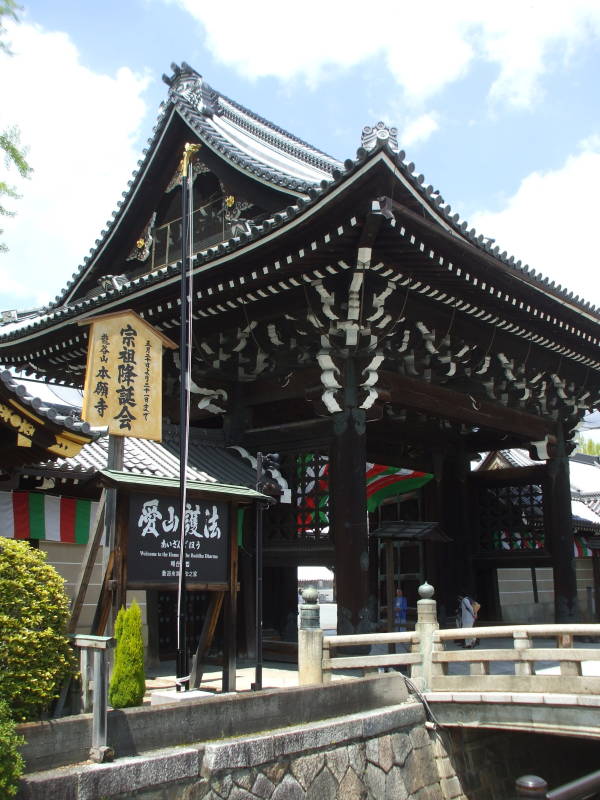
The Amida-dō or Buddha Hall is again on the left as you enter.
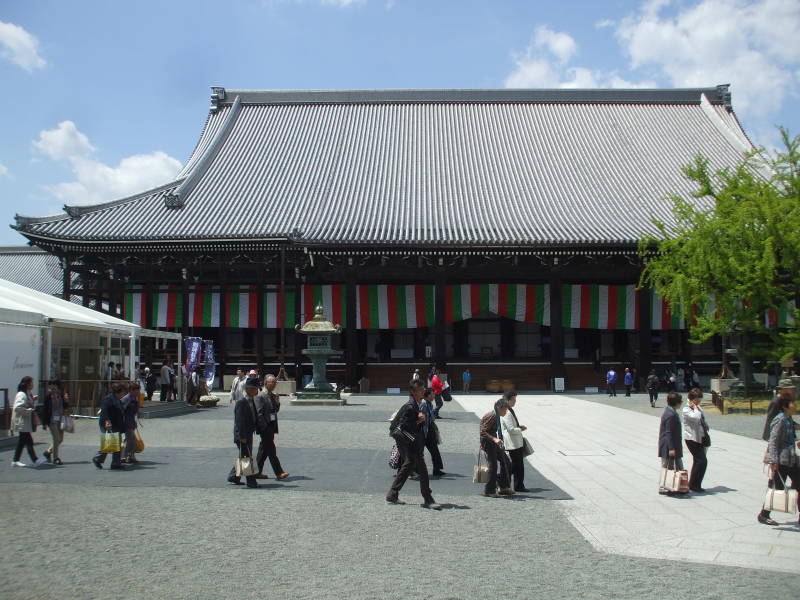
Below we see the Buddha Hall at left and the Goei-dō or Founder's Hall closer to us. It has a wooden image of Shinran, the founder of what became Jōdo Shinshū, Shin or Pure Land Buddhism. Shinren's image is flanked by portraits of the successive head priests.

A smaller educational hall is in a corner of the complex. Its main floor is mostly a book shop.


There were racks of literature at the entrance gates. Portuguese was frequently included. Much of the literature was primarily in Japanese, with Portuguese as the second language, and then, in lesser detail, English.
Brazil is home to the largest Japanese population outside Japan. The end of feudalism at the Meiji Restoration caused extreme poverty in Japan's rural population. Brazil's plan to entice Italians to immigrate to Brazil and work on coffee plantations hadn't worked as hoped. A 1907 treaty permitted Japanese migration to Brazil. Many made the move between the two World Wars, with another surge in 1955–1965.
They were preparing for a ceremony at Nishi Hongan-ji. Rows of chairs were set up in the Founder's Hall. The young current leader of the sect appeared on video screens.
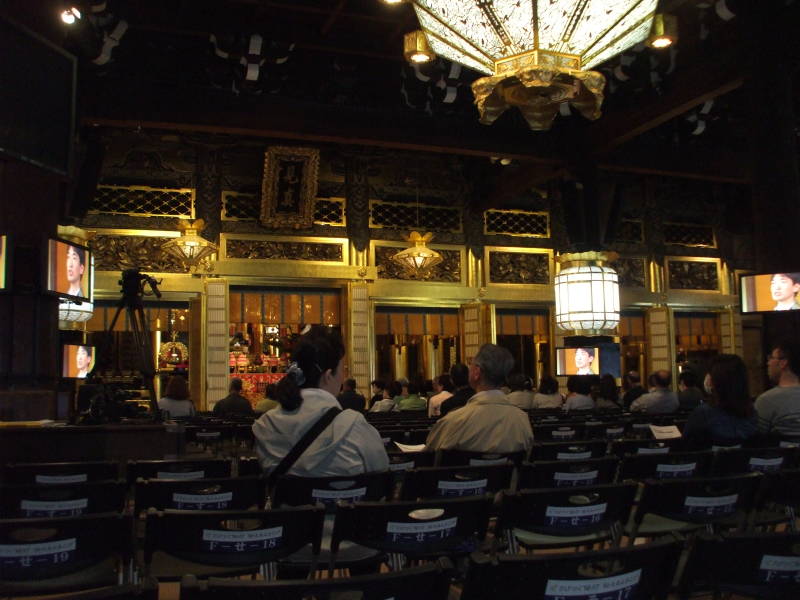
As frequently happened, I became a school project. A group of school kids asked if I could help them by answering some questions. Sure! It was the standard list of questions — where was I from, where had I been in Japan, where was I going.
I'm the third from the left in this picture. That is, if you start counting with the person on the far left as #1, and the next is #2, then #3, #4, and so on, I'm #3.
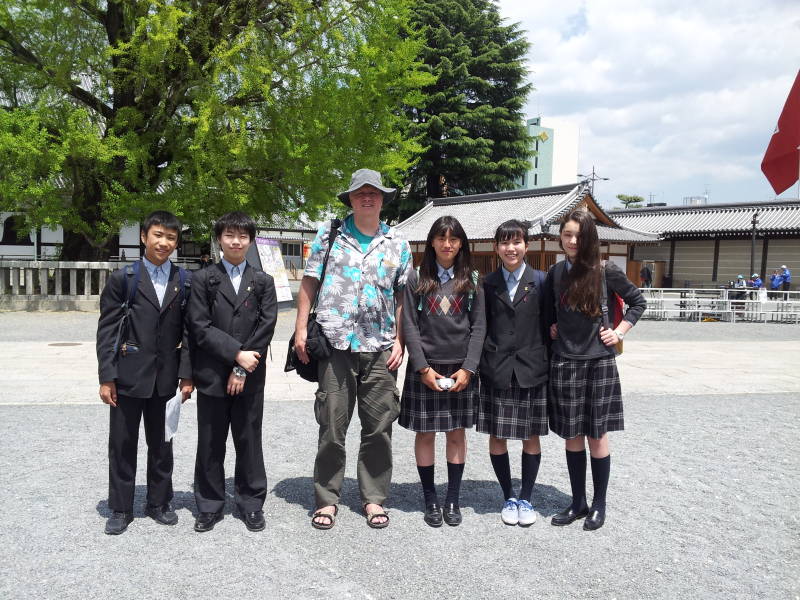
Sanjūsangen-dō
Sanjūsangen-dō or the Thirty-Three Ken Hall is across the river, just about 750 meters east of where I was staying. A ken is a traditional Japanese measurement, now standardized as 1 and 9/11 meters.
The tallest wooden structure is Tō-ji, a pagoda we'll see on the next stop. The largest wooden structure overall is Tōdai-ji, a temple in Nara. That one is the largest wooden building in the world.
The temple was founded in 1164. and its main hall dates from 1266. With 33 ken on either side of the center, the hall is 120 meters long. It's the longest wooden structure in Japan.
The hall contains 1000 standing Thousand-Armed Kannon statues. A large seated statue of Kannon is in the center. Kannon is the Japanese version of the Sanskrit अवलोकितेश्वर or Avalokiteśvara, or the Tibetan Chenrezik, or with some slight changes, the Chinese Guanyin. This is a bodhisattva who embodies the compassion of all Buddhas.
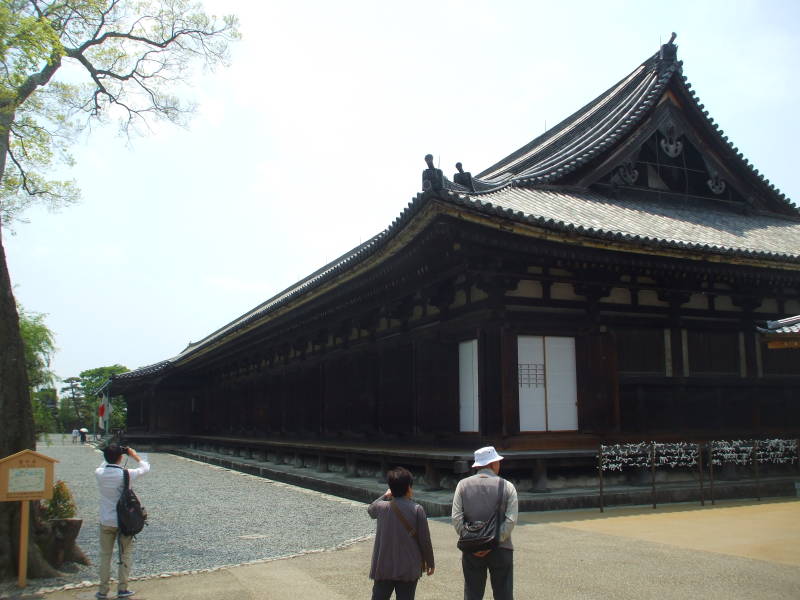
The Tōshiya or "Passing Arrow" archery tournament was held along the west veranda for 255 years, starting in 1606. That year a samurai named Asaoka Heibei shot 51 arrows in rapid succession down the length of the veranda
The modern version draws about 2,000 participants from all over Japan. They shoot at targets 50 to 100 centimeters in diameter, along the 120-meter length of the building.
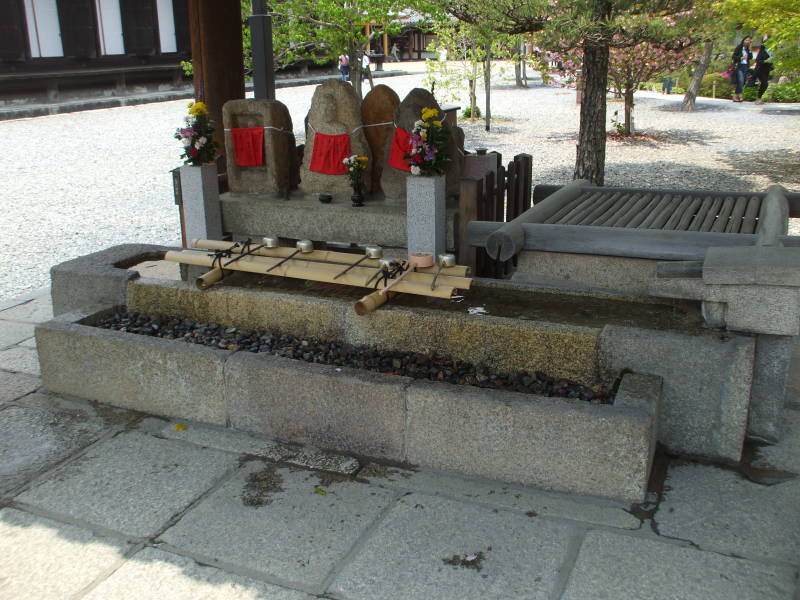
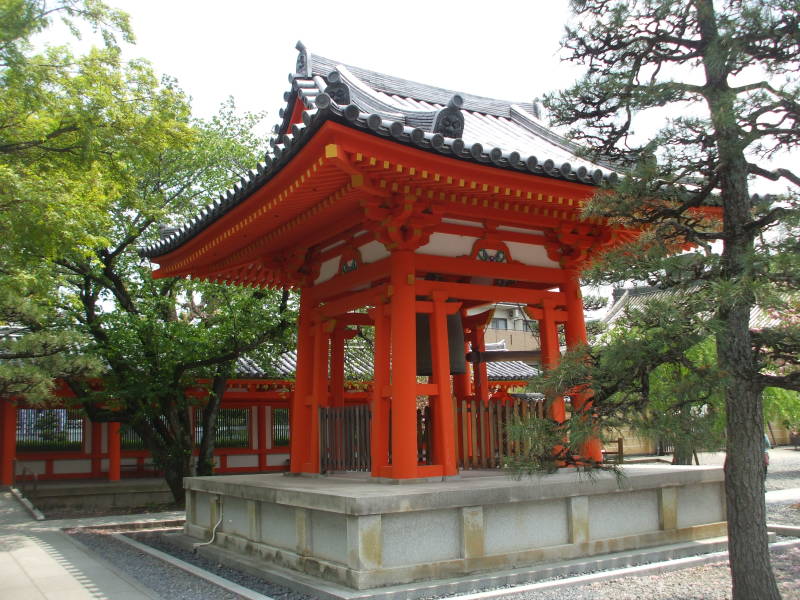
The 1,001 Kannons have 28 standing attendants, plus two larger attendants representing Fūjin, the god of the wind, and Raijin, the god of lightning, thunder, and storms.
The 28 mid-sized attendant statues represent guardian deities from the Sanskrit texts of Hinduism. It's Hindu deities guarding Buddhist deities.
It's all very syncretic. See this small structure approached through two torii, gates marking passage into more sacred space at a Shintō shrine.

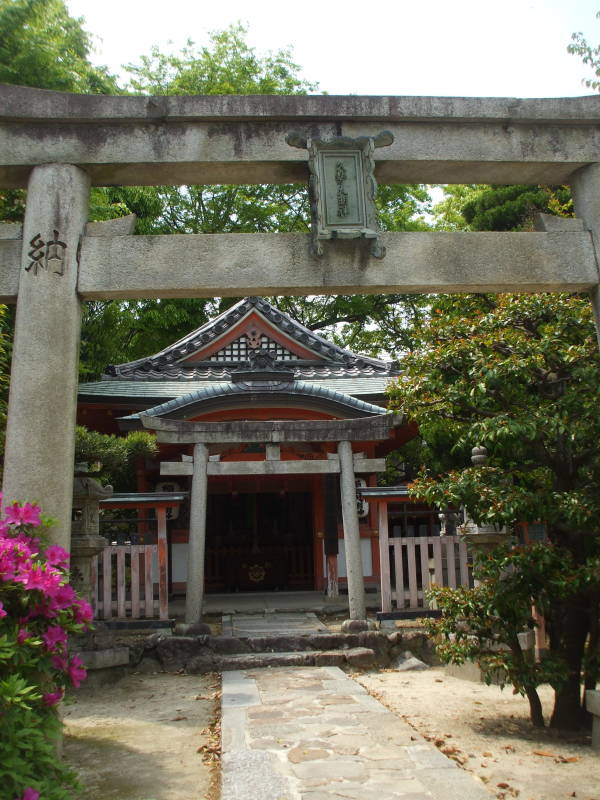

The offering box has the Dhamma Chakra or the Wheel of Dharma, which represents Buddhism and Gautama Buddha's teaching and walking the path to Enlightenment. It's also a symbol of Hinduism and Jainism.
This Buddhist (and Hindu, and Jain) symbol is in a very Shintō setting. You shake the heavy rope to rattle the bell at its top, to get the attention of the kami or spirit of the shrine. Unlike a Buddhist temple or shrine, there is no statue or picture or other representation of a manifestation of Buddha or a Boddhisattva. There are more torii, but no direct representation of a Shintō kami or spirit or deity.

Meanwhile this mostly Shintō shrine is part of the complex at a very significant Buddhist temple.
Let's go in the main hall. You can't take pictures inside, but you can buy a postcard.
The statues have 42 arms each, but this represents
Kannon's 1,000 arms through some Buddhist numerology.
Subtract the two human arms, then multiply by
25 planes of reality, and you have a thousand arms:
(42 - 2)×25 = 1,000
The standing statues are designed and carved from a common form, but each is a little different.
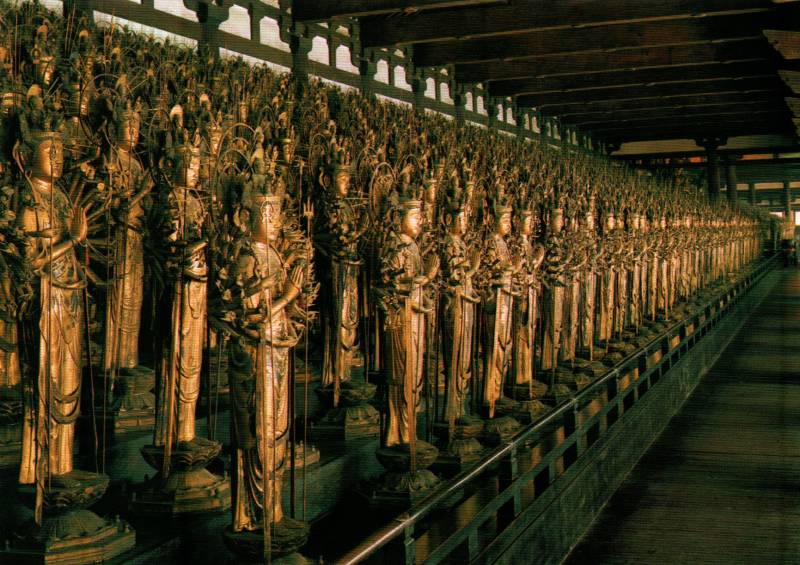
Tō-ji
Tō-ji is a temple complex a short distance southwest of Kyōto Station. It was once known as Kyō-ō-gokoku-ji, the Temple for the Defense of the Nation by the Means of the King of Doctrines. Remember, the Emperor lived in Kyōto.
The Shōgun was Buddhist, while the Emperor strongly favored the Shintō religion that said he was descended from the gods. Tō-ji was one of only three Buddhist temples allowed in the Imperial capital when it was founded in 796, just two years after the new capital was established. It's the only one of those three that survives today.
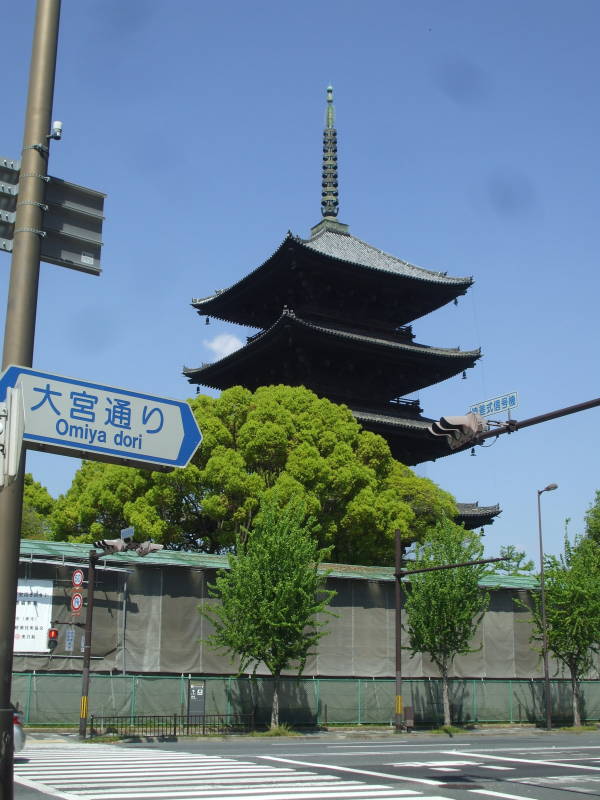
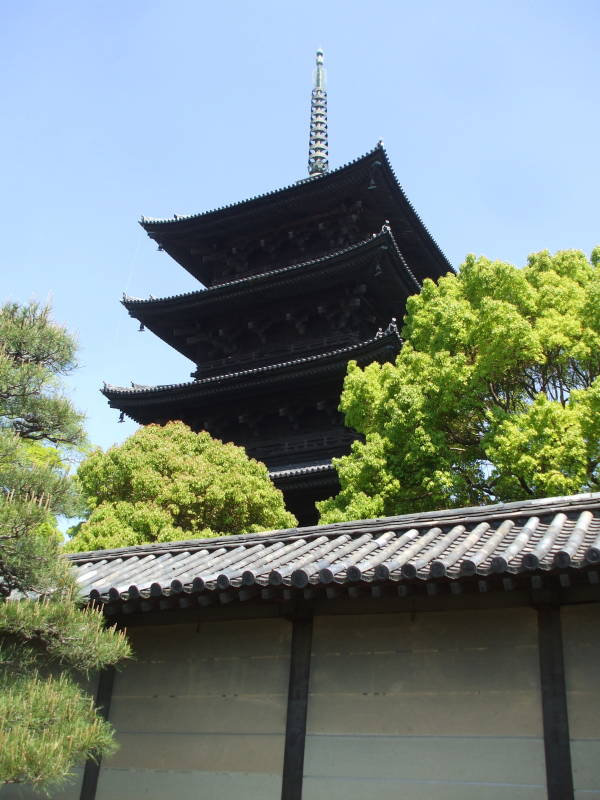
The Five-story pagoda of Tō-ji stands 55 meters tall, and is the tallest wooden tower in Japan. It was rebuilt in 1643, during the Edo period when the Tokugawa Shōgunate really ruled Japan and the Emperor was largely a figurehead.
KoyasanShingon, a form of Vajrayana Buddhism, was brought to Japan in 806 by Kūkai, who also founded the Koyasan monastery complex on a mountaintop well to the south of Kyōto.
Shingon temples were typically built in the mountains, with designs echoing those settings. But this one was built down here on the flat land near the Imperial palace, as it was to protect the nation.

There's a legend that says that Kūkai was the chief priest at Tō-ji during the time of a great drought. He and Shubin, his colleague and fellow chief priest from the temple of Sai-ji, were both praying for rainfall. Rain started, the drought was broken, and somehow it was determined that it was Kūkai whose prayers had brought the rain.
Shubin, violating every stereotype of Buddhist compassion, shot an arrow at Kūkai. A Jizō appeared in front of Kūkai, taking the arrow and and saving Kūkai's life.
Jizō, known in the original Sanskrit as Kṣitigarbha, meaning "Earth Treasury", or in more details as "Bodhisattva King Kṣitigarbha of the Great Vow", is Daigan Jizō Bosatsu in Japanese.
As a bodhisattva he vowed to instruct all beings until the arrival of Maitreya. He is one of the four principal bodhisattvas in East Asian Mahayana Buddhism.
You frequently see Jizō figures dressed in red bibs at temples or small shrines.
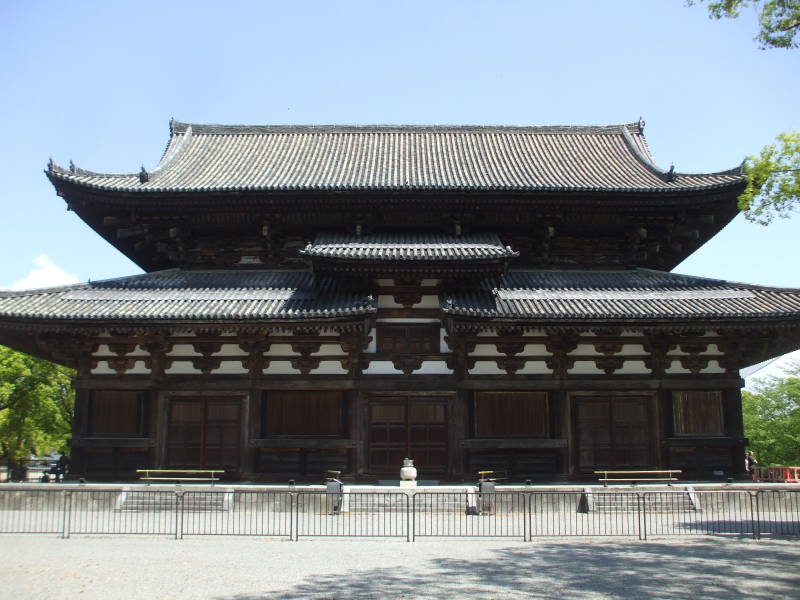
Kodo Hall, in the center of the temple grounds, houses 21 Buddhist statues that are among the oldest in Japan.
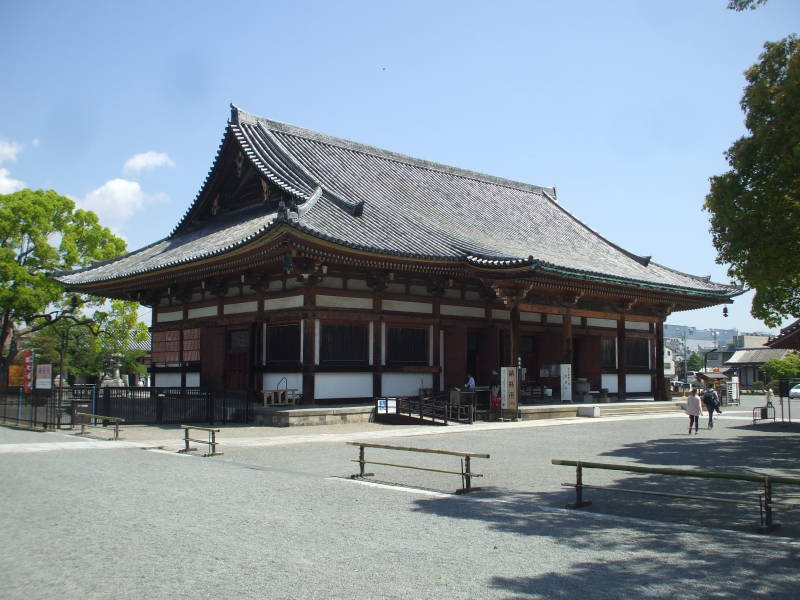
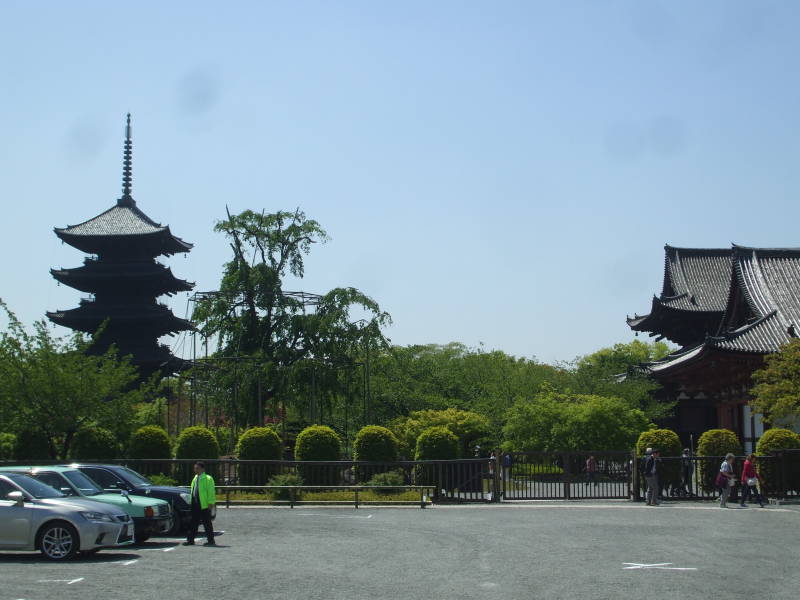
Kiyomizu-dera
Kiyomizu-dera is about 1.4 kilometers northeast from Sanjūsangen-dō. The obvious route by foot takes us through a large cemetery.
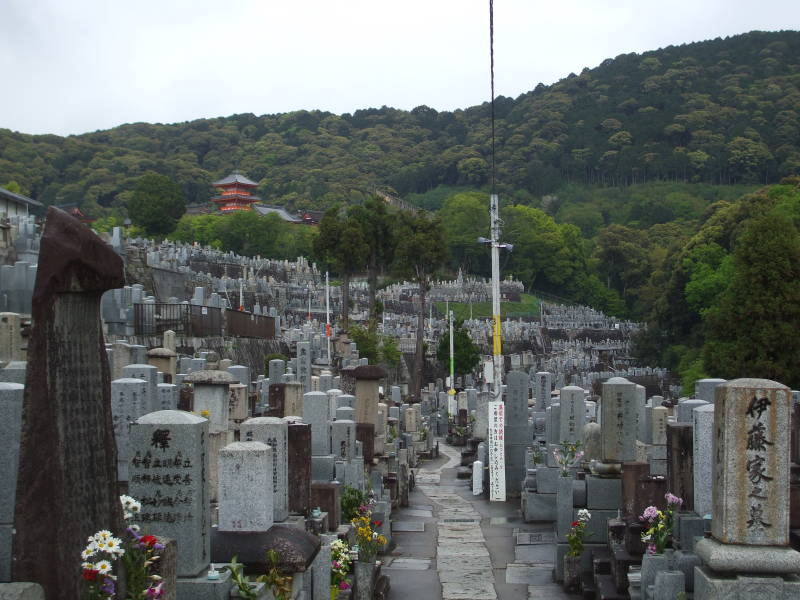
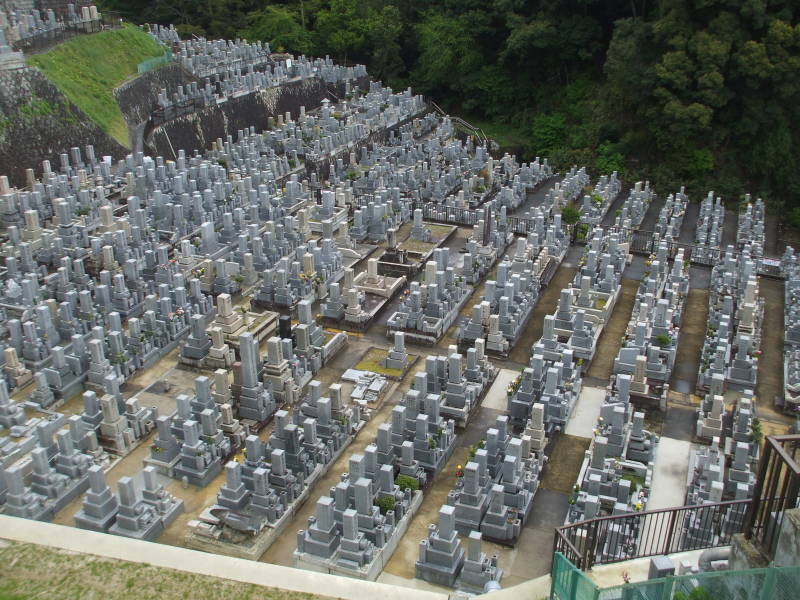
Kiyomizu-dera temple was founded in 778. Its present buildings were constructed in 1633 at under the order of the Shōgun Tokugawa Iemitsu. They are entirely wooden structures, they contain no nails or screws.
We have arrived at the outer gate of Kiyomizu-dera.
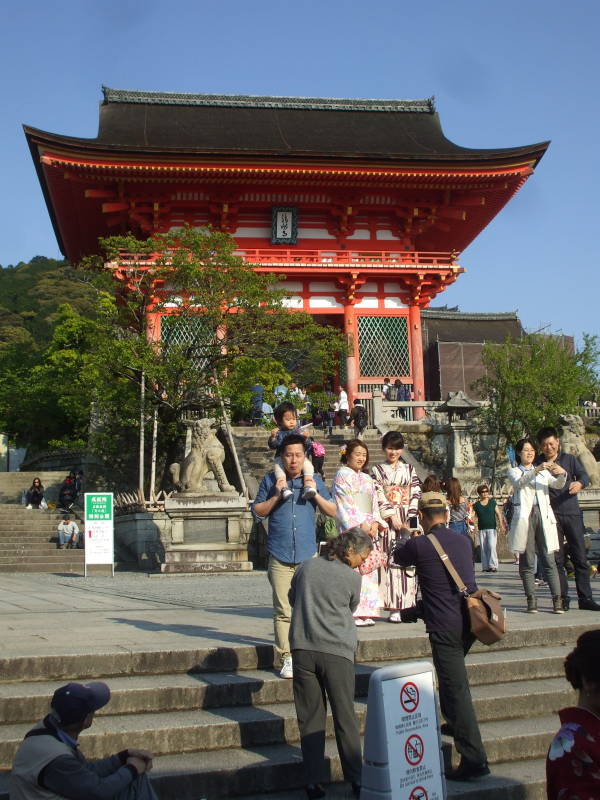

How do you take a picture in Japan?
You flash a peace sign. Always.
It seems to be a requirement.
A rented kimono is optional, but it's a frequently chosen option in Kyōto.
Kimono rental is a large business in Japan, especially in historic cities like Kyōto.
On we go, through the gate and around the pagoda.

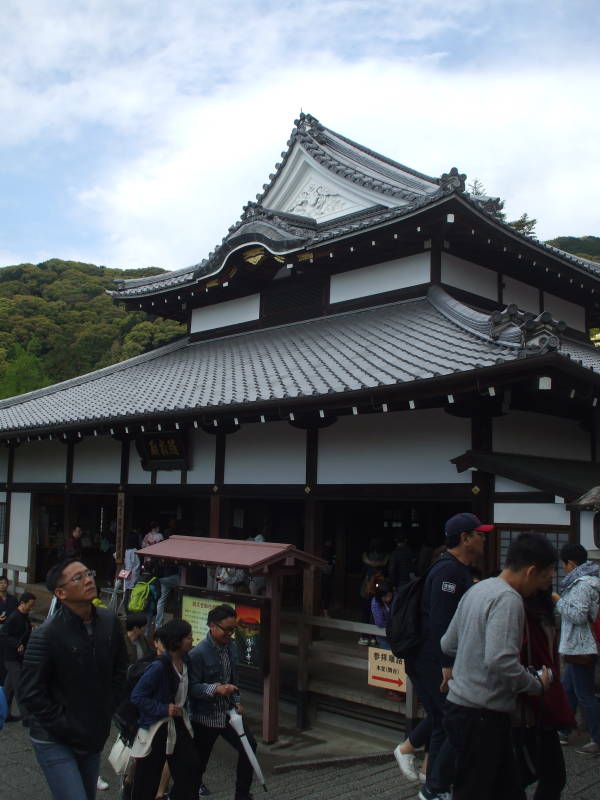
Zuigu Hall is a smaller structure here. For ¥100 you can go through the Womb of Zuigu-Bosatsu. They explain that Zuigu-Bosatsu is a motherly Buddha figure who grants any adequately sincere wishes. The basement of the hall is regarded as the Womb of Zuigu-Bosatsu.
You descend the staircase into total darkness. The railing of the staircase is a string of large wooden beads, about the size of grapefruit. The basement is completely dark, and you immediately make two or three right-angle turns so no light comes into the narrow area you're groping your way through along the wooden grapefruit.
As they say, there's no space for your attachment.
You come to the Zuigu-Stone, a rough barrel-shaped stone over waist tall. You make a wish, and turn the stone about its vertical axis. Zuigu-Bosatsuu will grant your wish if you're sincere enough. Then you grope your way back to the surface.

We're continuing on into the main temple of Kiyomizu-dera.

Many people are here just to look around, but the temple is busy functioning as a temple.

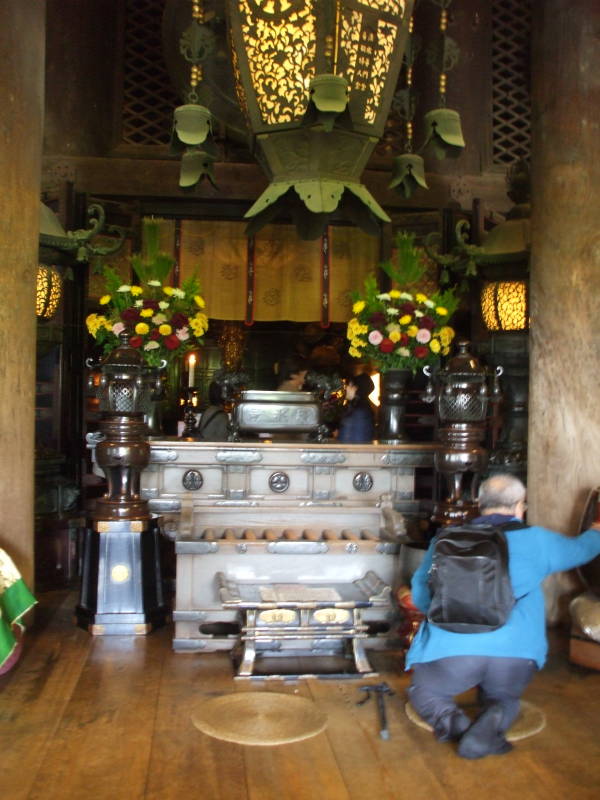
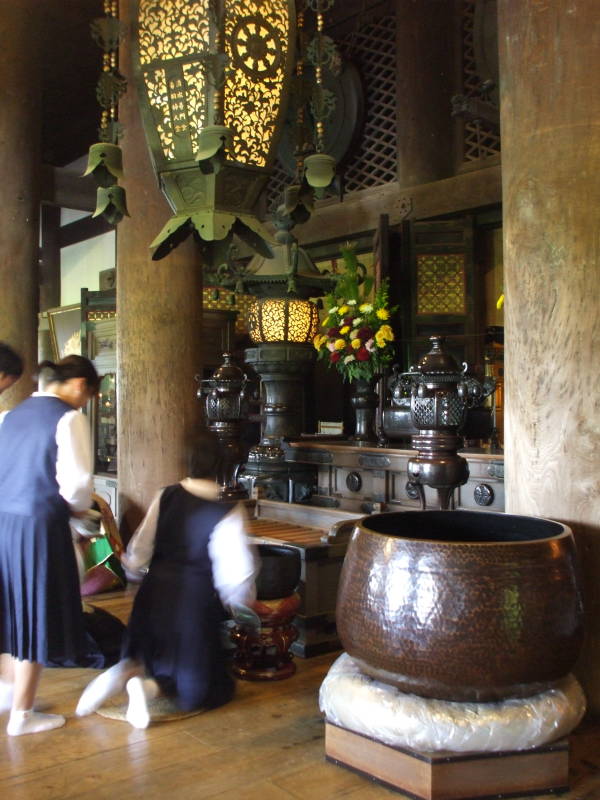
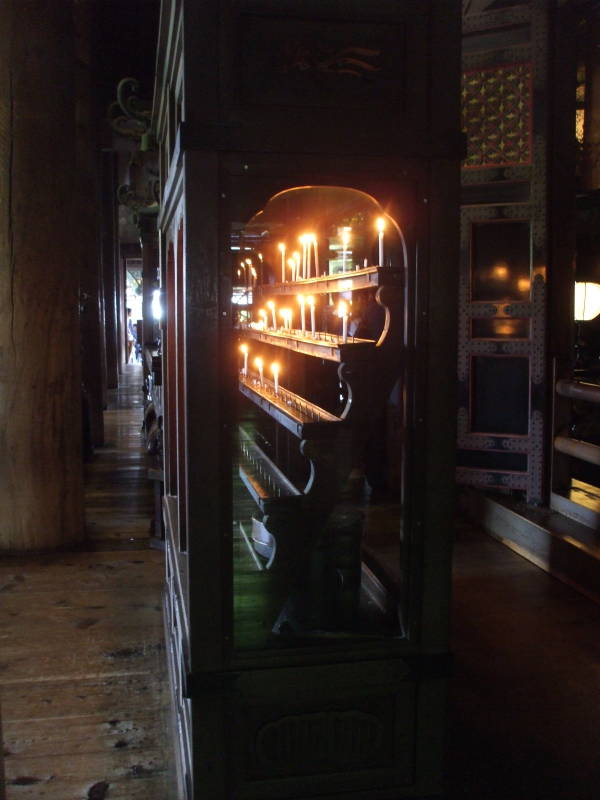
The main temple hall has a large cantilevered veranda extending out over the hillside.
The popular expression "to jump off the stage at Kiyomizu" is the Japanese equivalent of the English expression "to take the plunge", but with a real physical commitment.
The expression refers to a tradition that held that if you survive the 13-meter jump from the veranda, your wish will be granted.
During the Edo period of 1603–1868, when the Tokugawa shōgunate controlled Japan, 234 jumps were recorded. Of those, 200 or just over 85% survived. The practice was prohibited in 1872. Personally, I'll pay another ¥100 and go spin the stone again.
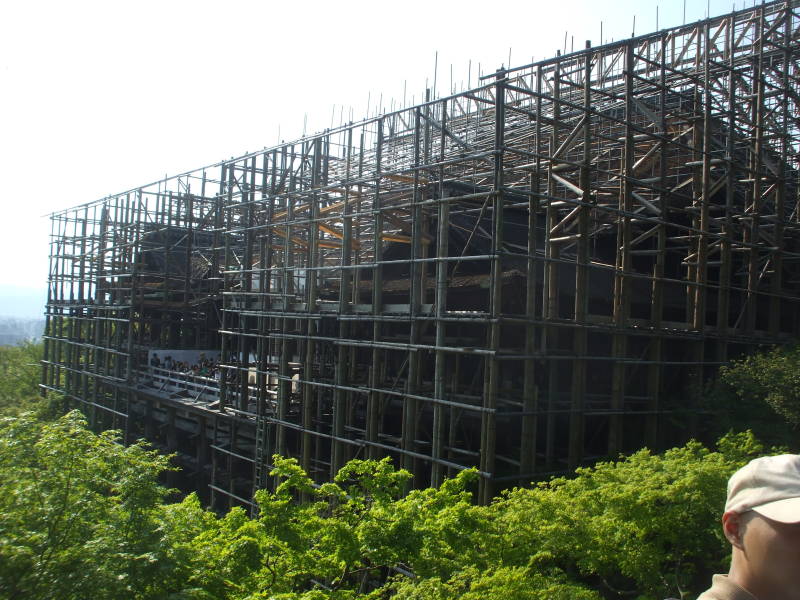
Meanwhile, during my visit, the main temple and its jumping platform was enveloped in some amazing all-wooden scaffolding.


Shintō shrines are also placed around the Buddhist temple complex.
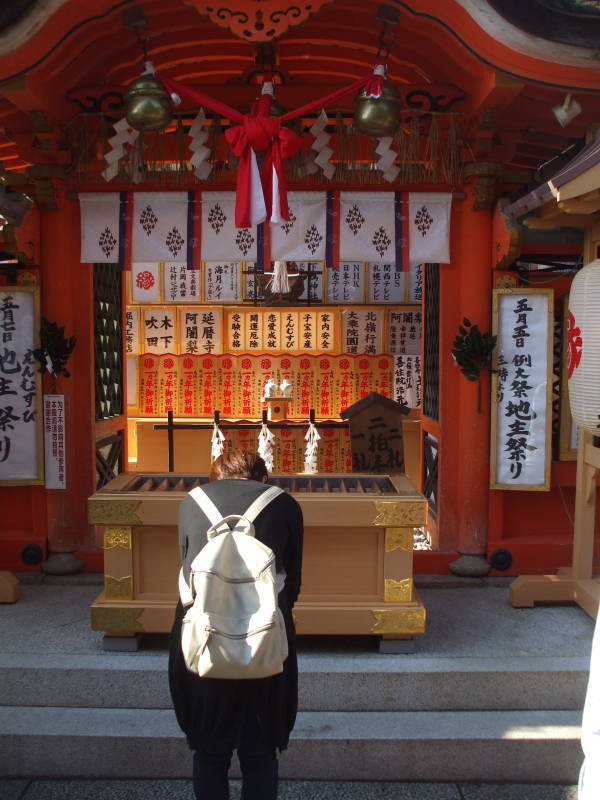

The Koyasu pagoda, associated with the Taisan-ji temple, is a short distance away. We'll walk that way, and look back past the Kiyomizu-dera pagoda and over Kyōto.
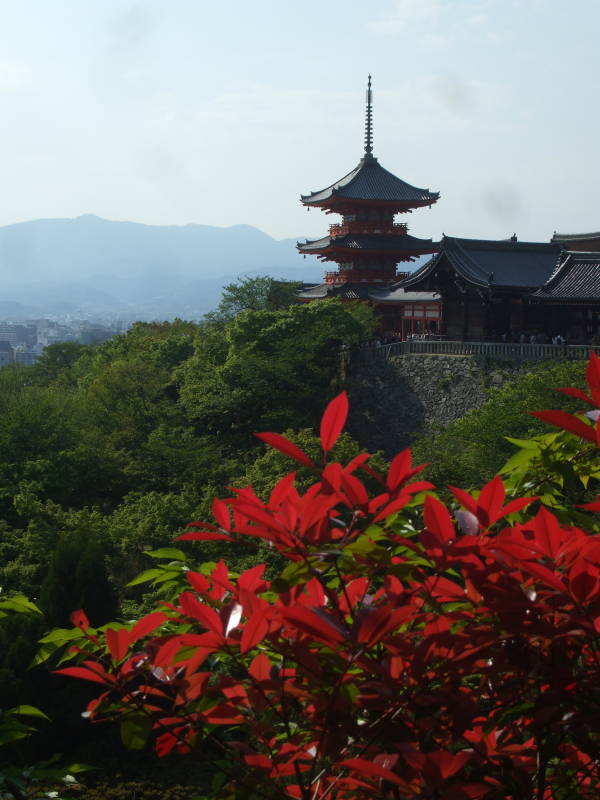

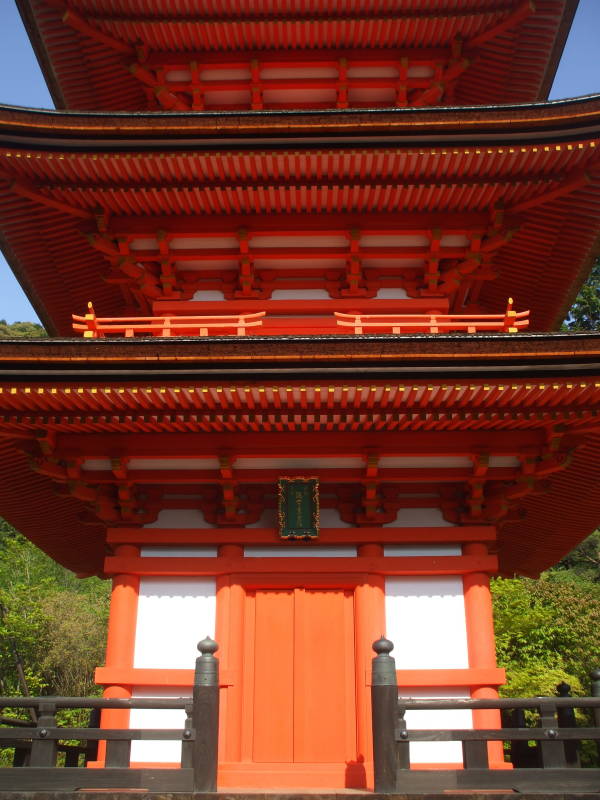
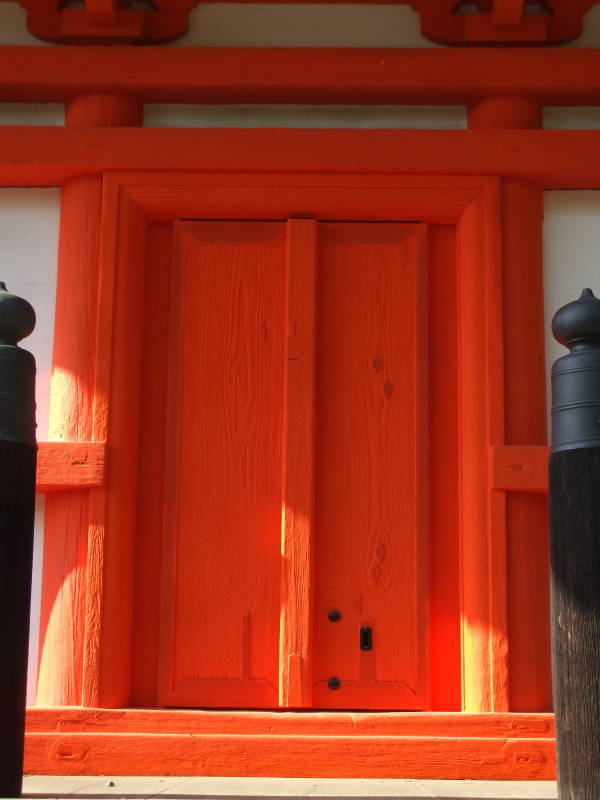

Kyōto Station
And finally, a temple to modern transportation and ramen.

Kyōto Station, especially at night, is like something out of a William Gibson novel.
Let's come back at night, and head upstairs and eat ramen:
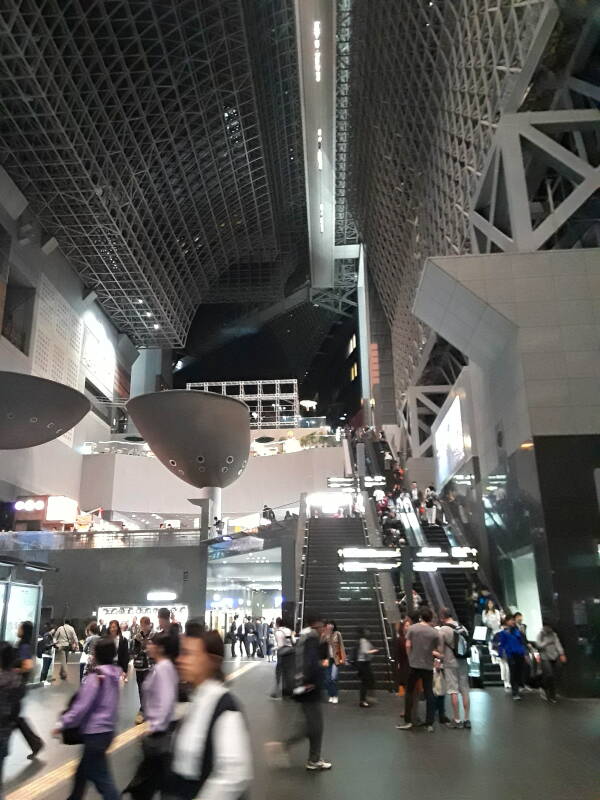
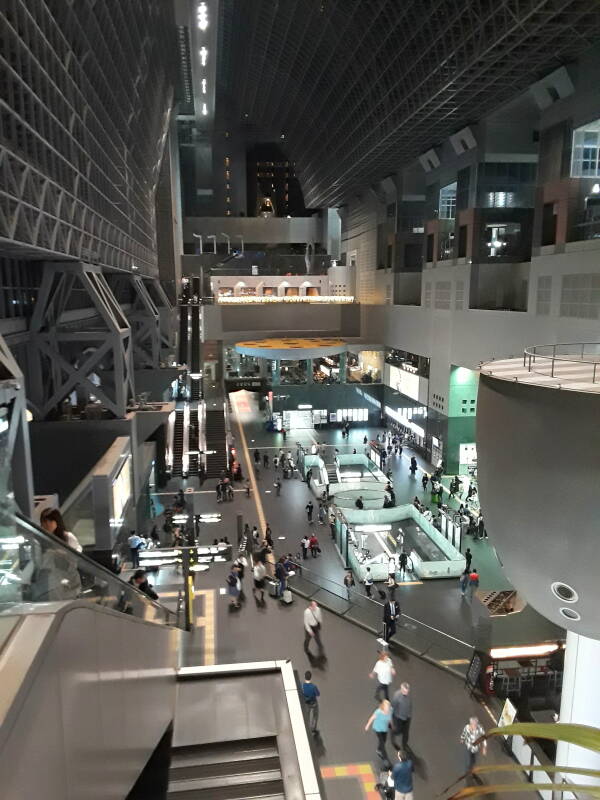
We're headed up to Kyōto Ramen Koji, or the Kyōto Ramen Alley on the 10th floor.
Yes, the tenth floor of the train station. Welcome to the future.
Take the series of escalators up to the 10th floor, which is still well below the top at 15 stories. Yes, of course the staircase is a video display.
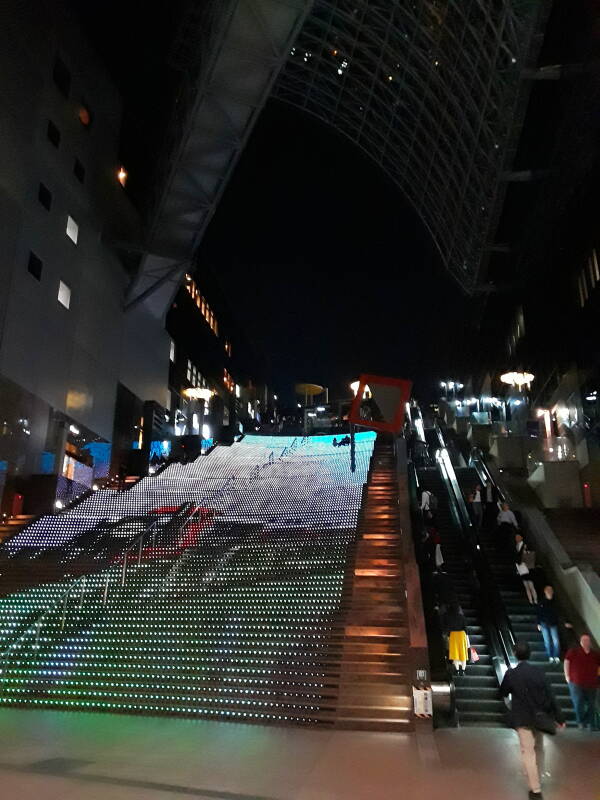
Ramen Alley has eight shops selling eight regional varieties of ramen, from Hokkaido in the far north to Kyūshū in the south.
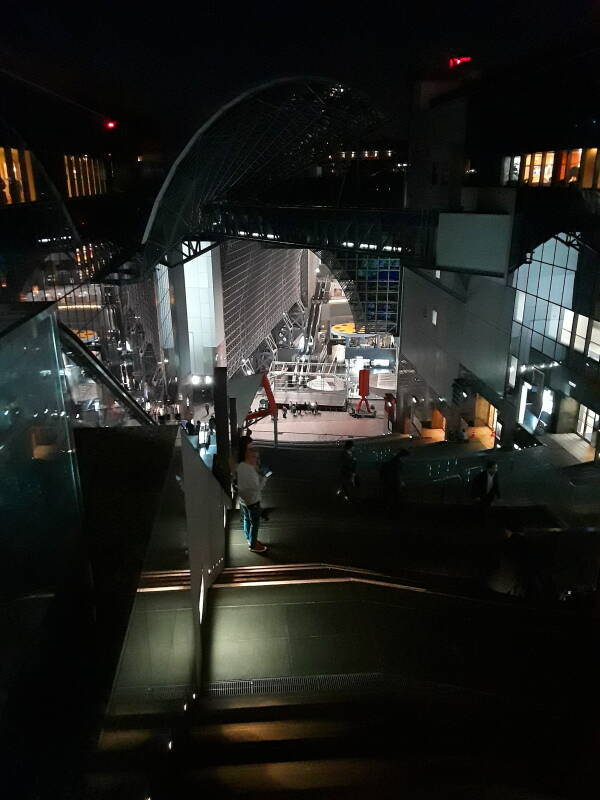
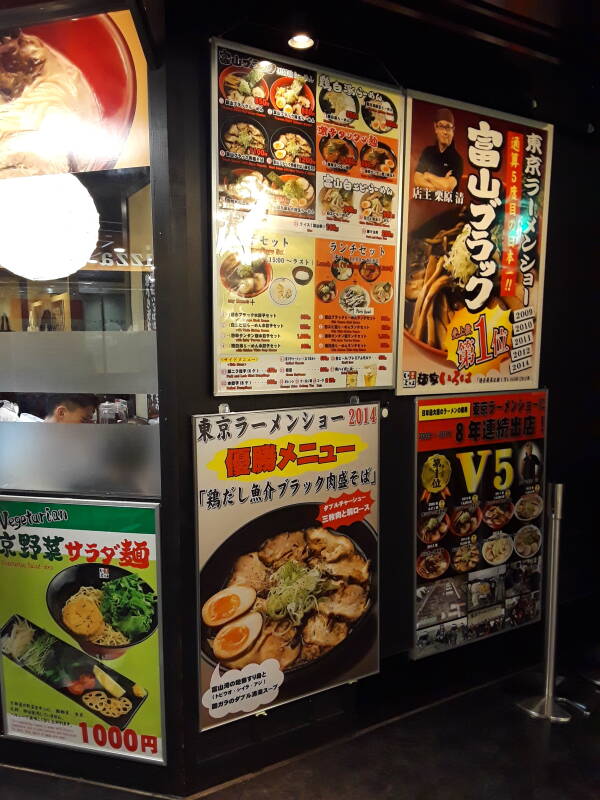
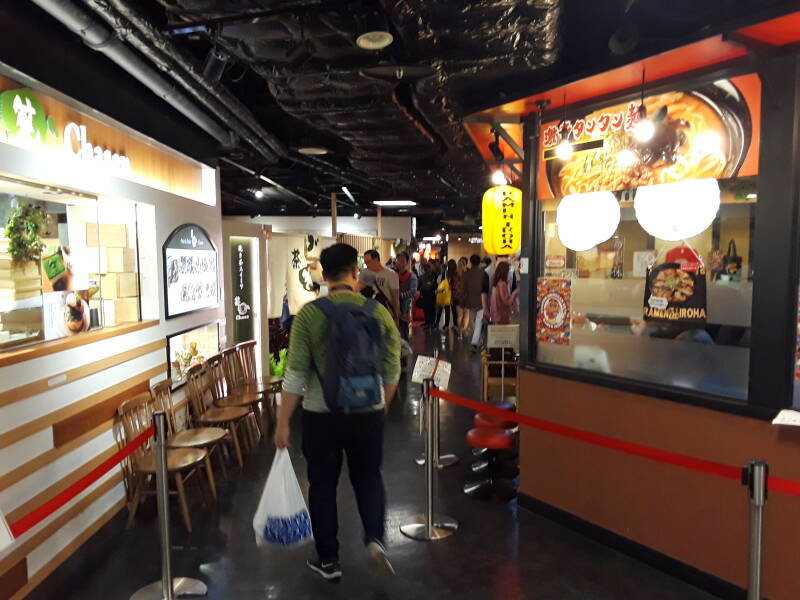
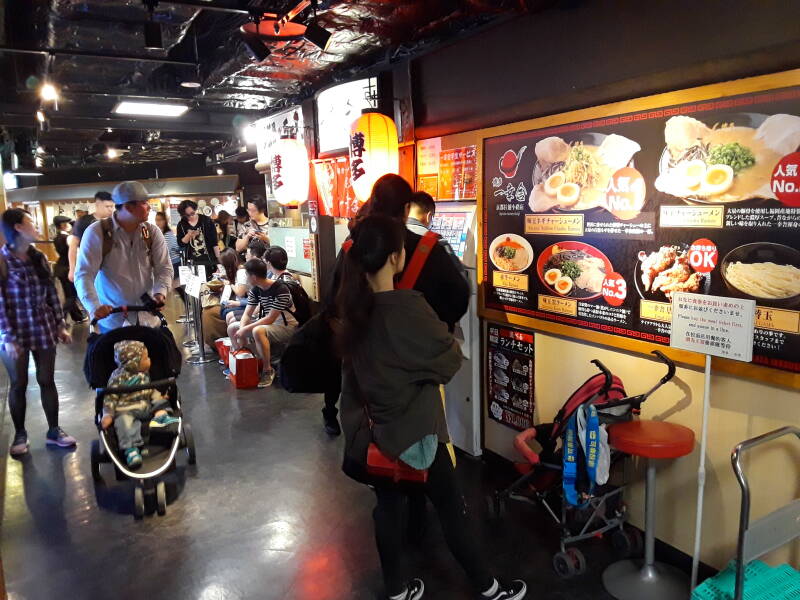
Select a restaurant, and decide what you want on the menu boards outside. Notice the price, and head toward the ticket machine.

Then purchase tickets from the machine, and proceed to the door.
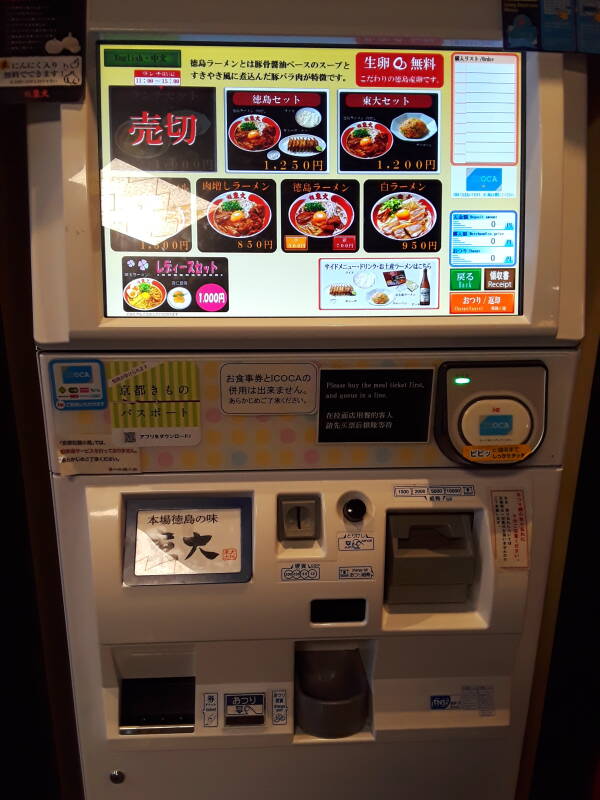
Staff will seat you. Prepare to ramen.

Spoons and hashi or chopsticks are on the narrow shelf, along with a pitcher of water and tissues as napkins. Pepper and toothpicks are under the shelf.

Most places provide raw eggs to add to your ramen.

Like this:
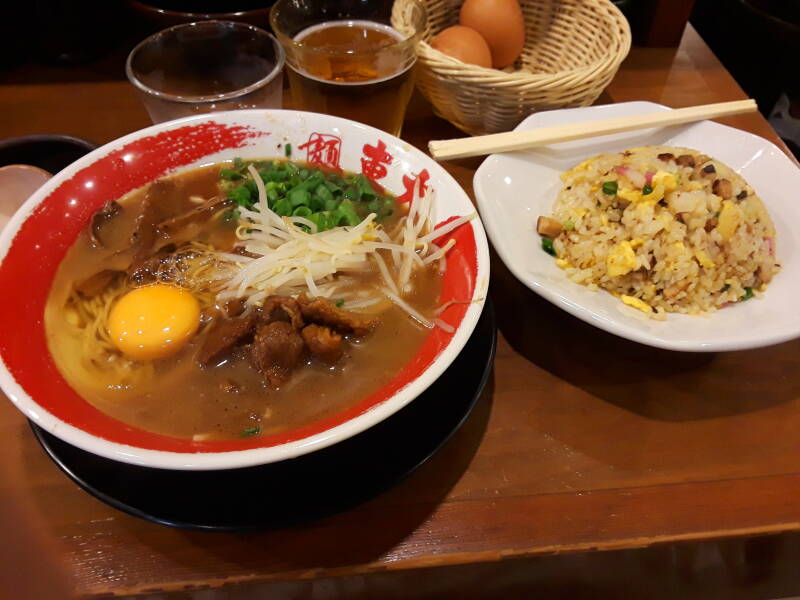
Further research was needed on other evenings:
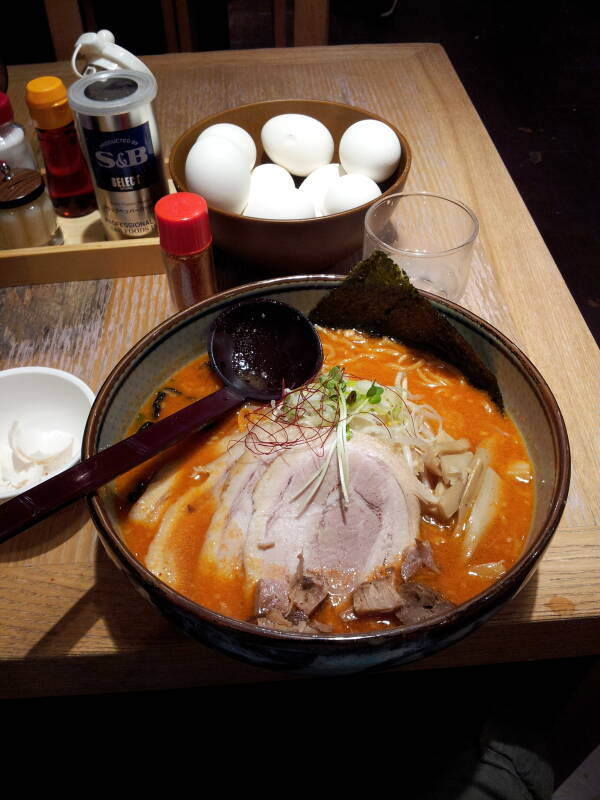
Choose your next stop around Kyōto:
Or, somewhere else around Japan:

